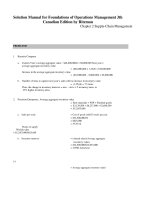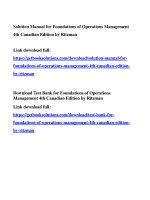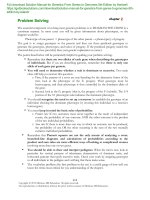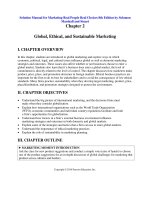Solution manual for m finance applications and theory 1st edition by cornett
Bạn đang xem bản rút gọn của tài liệu. Xem và tải ngay bản đầy đủ của tài liệu tại đây (147.91 KB, 7 trang )
Full file at />
CHAPTER 1 − INTRODUCTION TO FINANCIAL MANAGEMENT
Questions
LG1
1. Describe the type of people who use the financial markets.
The financial markets are used by people who have extra money now and want it to grow
for their future. They offer this capital through the financial markets to others who have
good ideas and opportunities, but need the capital to implement them. These types of people
are denoted as Type 2 and 3 people in Figure 1.1.
LG1
2. What is the purpose of financial management? Describe the kinds of activities that
financial management involves.
Financial management is the process of making decisions for the acquisition, use, and
repayment of capital. Decisions for the acquisition of capital can include how the business
is organized, what type of capital should be obtained, and how much capital should be
obtained. Decisions for the uses of capital include what new business projects to invest in,
what capital to retain to fund ongoing projects, and to reduce taxation. Decisions for the
repayment of capital involve paying capital back to its providers.
LG2
3. What is the difference in perspective between finance and accounting?
Accounting focuses on recording and presenting the past business activities. This
information is good for evaluating past performance. The finance function uses this past
data along with current information to make decisions on what business activities to do now
and in the future. Decisions about the future involve much uncertainty, so risk evaluation is
part of the finance job.
LG3
4. What personal decisions can you think of that will benefit from learning finance?
Learning finance will help the student build wealth and reduce costs in their personal life.
After taking this class, the student should be able to make good decisions about funding
their future retirement and investment allocations. People with finance knowledge can also
reduce costs by making good decisions in borrowing while buying cars, homes, and using
credit cards.
LG4
5. What are the three basic forms of business ownership? What are the advantages and
disadvantages to each?
The three basic business forms are the sole proprietorship (SP), the partnership (Part), and
the corporation (Corp). Advantages and disadvantages can be determined along several
dimensions: control, risks, access to capital, and taxation. The SP owner has total control of
buy this full document at
Full file at />
business decisions. Control decreases for owners of Part and then Corp. The owner has
high risk to their personal wealth in a SP and Part, but low risk in a Corp. Access to capital
is addressed in the next question. Lastly, SP and Part owners are taxed as if the business was
personal income. The Corp owner is taxed twice, once at the corporation level and then
again at the personal level.
LG4
6. Between the three basic forms of business ownership, describe the ability of each form to
access capital.
The corporation has the highest access to capital. It can acquire new equity capital from the
public market. Also, banks are more willing to lend to corporations. Debt investors are also
more likely to buy the bonds of a corporation. Partnerships have the next best access to
capital. With larger numbers of partners involved with the business, the more likely banks
will lend and debt investors will buy its bonds. Partnerships do not have access to the public
equity market. Lastly, sole proprietorships have poor access to capital. Generally speaking,
the sole proprietor cannot borrow as much money from banks or debt investors.
LG4
7. Explain how the founder of a business can eventually lose control of the firm. How can
the founder ensure this will not happen?
When the founder wants the business to grow quickly, more capital is required. In the early
stages of a small fast growing company, it is equity capital that is available. In other words,
the founder must give up a portion of his/her ownership to other investors. As this process
continues over time, the founder may find that he/she no longer owns a majority of the firm.
There may come a time when enough of these other owners that own a combined 50+% of
the firm come together and change the leadership of the firm.
LG5
8. Explain the shareholder wealth maximization goal of the firm and how it can be
measured. Make an argument for why it is a better goal than maximizing profit.
The shareholder wealth maximization goal of the firm states that managers should run the
company in such a way that maximizes the wealth of the stockholders. Progress for this goal
can be measured using the stock price. The stock price contains what investors know about
the current profitability of the firm and expectations about future profits and opportunities.
Maximizing profit is a similar goal, but quite as good. A manager could maximize this
year’s profit at the detriment of future profits. This would not be good for long-term
investors.
LG5
9. Name and describe as many corporate stakeholders as you can.
Stockholders, managers, and employees are all stakeholders with a very close relationship to
the firm. Customers, suppliers, banks, and bondholders have a close relationship to the firm.
Local government, local community people, and people who enjoy the environment are also
stakeholders.
buy this full document at
Full file at />
LG6
10. What conflicts of interest can arise between managers and stockholders?
Stockholders own the firm and hire managers to run the firm. Managers, therefore, control
the day to day operations of the firm. Since the stockholders can’t see these decisions, it is
possible that the managers will manage the firm in such a way that it benefits themselves
more than the shareholders. This conflict of interest can manifest as higher costs to the firm
for things that benefit the managers. It can also show up in decisions to make poor
acquisitions of other firms in order to make the company bigger and then argue for higher
managerial pay.
LG6
11. Figure 1-9 shows firm monitors. In your opinion, which group is in the best position to
monitor the firm? Explain. Which group has the potential to be the weakest monitor?
Explain.
Auditors are in a great position to monitor the company. They are specifically tasked with
identifying and reporting the activities of the company. The members of the Board of
Directors are also in a good position to monitor the firm because they are at a high position
and are charged with hiring, firing, and monitoring management. These two groups do well
when they are independent of management. Financial analysts are not in a good position to
monitor management. They have no special ability to acquire private information about
management’s activities. In addition, they sometimes experience conflicts of interest in
their rating of firms.
LG6
12. In recent years, governments all over the world have passed laws that increased the
penalties for executives’ crimes. Do you think this will deter unethical corporate managers?
Explain.
Better monitoring and increased punishment should reduce unethical behavior from
corporate managers for awhile. Executives are smart enough to not push any grey areas or
commit fraud during this time with heightened awareness of executive crime. However, this
focus will wane many years from now. Although these new laws will still apply, unethical
managers may once again behavior badly.
LG6
13. Every year, the media reports on the vast amounts of money (sometimes hundreds of
millions of dollars) that some CEOs earn from the companies they manage. Are these CEOs
worth it? Give examples.
When a CEO earns hundreds of millions of dollars, it is usually because they have had an
incentive compensation plan pay off big. These incentive plans have been given many years
before. If the firm’s stock price increases enough over the years, then the CEO’s stock
options become very valuable. If the CEO’s leadership over the years is responsible for the
increase in stock price, then it is likely worth it. Of course, if the stock price later declines,
then it would not be worth it. Steve Jobs of Apple Computer earned $646 million in 2006.
buy this full document at
Full file at />
While this is an obscene amount of money, Jobs’ return to Apple heralded the iPod, iTunes,
iPhone, and better computers. In the ten years he has run Apple, the stock has gone from an
equivalent $5 per share to $80 per share in 2006 and to $175 in 2007. This pay is all
incentive pay as he earns a salary of $1.
LG7
14. Why is ethical behavior so important in the field of finance?
Ethical behavior is so important because finance involves the management of other people’s
capital. People must be willing to invest their capital with others if the economy is to thrive.
But nobody wants to offer their capital if they believe they will be taken advantage of.
Thus, it is very important to the economy to have confidence in ethical behavior.
LG7
15. Does the goal of shareholder wealth maximization conflict with behaving ethically?
Explain.
No. The goal of shareholder wealth maximization is to maximize the stock price over the
long term. Unethical behavior may temporarily increase the stock price, but it will
eventually be found out. When that happens, the company is punished by a falling stock
price.
LG8
16. Describe how financial institutions and markets facilitate the expansion of a company’s
business?
Companies need additional capital to fund large business expansion opportunities. Financial
institutions and markets provide that capital. A firm’s opportunities may offer higher profits
to the firm than the costs paid for the capital. So facilitate the firm’s expansion also leads to
increased value of the firm.
Research It!
Corporate Governance
The corporate governance system continues to evolve. After the very visible governance
failures in the early 2000s, the national focus was placed on this issue. The U.S.
government passed new laws regarding auditing, board of directors’ composition, and
executive behavior. Directors also began to change the form of executive incentive
compensation. Some believe the changes went too far and have placed a costly burden on
public corporations. Others believe that some new laws did not go far enough to reign in
the extreme levels of executive compensation. For information on this ongoing debate, visit
the leading independent source for U.S. corporate governance and executive compensation,
The Corporate Library at www.thecorporatelibrary.com.
SOLUTION: The Corporate Library offers many data and information services on
corporate governance. In addition, they provide a commentary on various decisions made by
company executives and provide advice on proposed new laws and regulation.
buy this full document at
Full file at />
Integrated Minicase: Corporate Citizenship
What is a company’s responsibility to society? Proponents of the modern view of
stakeholder theory argue that companies have a social obligation to operate in ethically,
socially, and environmentally responsible ways. This active approach is referred to as
corporate social responsibility (CSR) or corporate citizenship. The idea of corporate
citizenship is that a firm should conduct its business in a manner that meets its economic,
legal, ethical, and philanthropy expectations.
The economic responsibilities have the highest priority. A firm must be efficient and
survive over the long term in order to be useful to society. It must also execute its business
activities in a legal and ethical way. These responsibilities are those over and above the ones
codified in laws and are in line with societal norms and customs. They are expected, by
society even though they may be ill-defined. This could include things such as
environmental ethics. Philanthropy is the least important priority. The corporate citizenship
concept focuses more on engagement with stakeholders to achieve mutual goals.
Some corporations have responded to this trend by including CSR-oriented
statements in their corporate goals. These statements recognize that CSR has value in a code
of conduct or ethics, a commitment to local communities, an interest in employee health and
education, an environmental consciousness, and recognition of social issues (e.g. diversity,
social fairness, etc.). In October of 2006, The Conference Board surveyed large U.S. firms
on corporate citizenship issues, 198 firms responded. When asked about the top 3 CSR
topics receiving attention at the company, the results were:
What is the motivation for these companies to fund CSR programs? When asked, 92
percent stated that enhancing corporate reputation was very important. Other popular
responses were for recruiting and retention (78 percent), reducing risk (65 percent).
buy this full document at
Full file at />
a. Wal-Mart generates over $11 billion in profits per year and is the largest corporate
employer in the U.S., with 1.4 million employees. But Wal-Mart also seems to be coming
under increasing pressure from different social groups for its business practices.
Community groups have worked to keep Wal-Mart from coming to their towns. Wal-Mart
claims that its low prices help everyone in the community. Also by giving over $270
million to charity last year, it is the largest corporate cash contributor in the U.S. Go to
www.wakeupwalmart.com and describe the current stakeholder problems with Wal-Mart.
Also go to www.walmart.com and describe what Wal-Mart is doing to engage these
stakeholders. What is your opinion?
b. What activities might companies engage in to satisfy the four components of corporate
citizenship: economic, legal, ethical, and philanthropy?
c. By embracing citizenship goals, assess whether corporations can insulate themselves
from many activist actions, thereby avoiding negative media events.
SOLUTION:
a. Wake up Walmart.com summarizes its many complaints on its website with the following
paragraph:
“The truth is that Wal-Mart has let America down by lowering wages, forcing good
paying American jobs overseas, and cutting costs with total disregard for the values that
have made this nation great. Wal-Mart has needlessly exploited illegal immigrants, faces
the largest gender discrimination lawsuit in history, forced workers to work in an unsafe
environment, and -- incredibly -- broken child labor laws.”
Wal-Mart aggressively publicizes its charitable contributions. At the time of this writing,
their website was promoting the following gifts: scholarships for thousands of students, 3
million meals (about $1 million) to America’s Second Harvest, $200,000 to Salvation Army,
$1.2 million to schools, and many more. In addition, Wal-Mart promotes its sustainability
efforts. Its website reports:
“At Wal-Mart, we know that being an efficient and profitable business and being a good
steward of the environment are goals that can work together. Our environmental goals at
Wal-Mart are simple and straightforward: To be supplied 100 percent by renewable
energy; to create zero waste; and to sell products that sustain our resources and the
environment.”
b. The best economic component is to strive for shareholder wealth maximization. This will
help the firm survive for the long-term to benefit its employees and the communities it
operates in. Firms should always behave in a lawful manner. U.S. firms should obey U.S.
laws even when operating in countries where a behavior may be legal there, but illegal in
the U.S. The firm can behave in an ethical manner. Among other things, this means
producing products that that are not harmful. This is important for the long-term success of
the firm. Lastly, the company can give to charity at both the local, community level and to
large, national organizations.
buy this full document at
Full file at />
c. Companies can insulate themselves to some degree by being aggressive in promoting its
citizenship activities. That is, firms can build up some goodwill with its good deeds.
However, there are many activists with many topics. It is difficult to be known for good
citizenship activities in all things. This takes manager’s time and effort and company
money that might be better served focusing on the business of the firm. So, a firm that has a
good reputation for treating its people well might still be criticized by environmental
activists. Firms that are known for contributing to local communities might be criticized on
its activities in foreign countries.
buy this full document at









